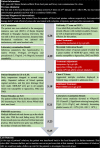Polymyxin B-induced skin hyperpigmentation: a rare case report and literature review
- PMID: 29973293
- PMCID: PMC6032769
- DOI: 10.1186/s40360-018-0226-1
Polymyxin B-induced skin hyperpigmentation: a rare case report and literature review
Abstract
Background: Polymyxin B (PMB), which is regarded as the ultimate antibacterial treatment against some intractable gram-negative bacteria with its outstanding anti-bacterial activities, inflicts several adverse effects on patients. However, skin hyperpigmentaion (SH) induced by PMB is very rare. Here, we report a case of polymyxin B-induced skin hyperpigmentation (PMB-iSH) in a 21-year-old female. To the best of our knowledge, this is the first case of PMB-iSH in China.
Case presentation: A 21-year-old female patient with sepsis received the administration of PMB by intravenous injection for the treatment of multi-drug resistant Klebsiella pneumoniae (MDR-KP) infection. She later suffered from a rare adverse drug reaction (ADR), namely PMB-iSH, after 5-day PMB administration during her treatment. There were multiple red rashes spread on the whole body skin at first. With the rashes fading away, SH with dark round spots appeared, associated with no pain or pruritus. The skin of the head and neck was darkened evidently, and dark brown spots were spread on the skin of trunk and limbs. About a month after her admission, urged by the relatives, the patient was transferred back to the local hospital for further treatment in the end, and her skin color didn't recover to the previous state at that time.
Conclusion: Both our case and the literature review highlight that PMB can give rise to SH indeed. Clinicians and pharmacists should attach great importance to this rare pigmentary disorder and further investigation is warranted.
Keywords: Case report; Polymyxin B; Sepsis; Skin hyperpigmentation.
Conflict of interest statement
Ethics approval and consent to participate
This study was approved by Ruijin Hospital Institutional Review Board and has been performed in accordance with the ethical standards laid down in “Declaration of Helsinki 1964” and its later amendments or comparable ethical standards. One patient was enrolled in the study and informed consent forms were signed by this patient.
Consent for publication
Written informed consent was obtained from the patient to the publication of this case report. A copy of the written informed consent is available for the review by the editor of this journal.
Competing interests
The authors declare that they have no competing interests.
Publisher’s Note
Springer Nature remains neutral with regard to jurisdictional claims in published maps and institutional affiliations.
Figures
Similar articles
-
Polymyxin B-induced skin hyperpigmentation.Transpl Infect Dis. 2020 Oct;22(5):e13312. doi: 10.1111/tid.13312. Epub 2020 May 27. Transpl Infect Dis. 2020. PMID: 32386075
-
Skin hyperpigmentation following intravenous polymyxin B treatment associated with melanocyte activation and inflammatory process.J Clin Pharm Ther. 2017 Oct;42(5):573-578. doi: 10.1111/jcpt.12543. Epub 2017 May 11. J Clin Pharm Ther. 2017. PMID: 28497462
-
Hyperpigmentation on head and neck caused by polymyxin B: A rare case.Niger J Clin Pract. 2023 Sep;26(9):1393-1395. doi: 10.4103/njcp.njcp_185_23. Niger J Clin Pract. 2023. PMID: 37794556
-
Successful treatment of ceftazidime-resistant Klebsiella pneumoniae ventriculitis with intravenous meropenem and intraventricular polymyxin B: case report and review.Clin Infect Dis. 1999 May;28(5):1134-8. doi: 10.1086/514754. Clin Infect Dis. 1999. PMID: 10452648 Review.
-
Pharmacokinetics/pharmacodynamics of colistin and polymyxin B: are we there yet?Int J Antimicrob Agents. 2016 Dec;48(6):592-597. doi: 10.1016/j.ijantimicag.2016.09.010. Epub 2016 Oct 18. Int J Antimicrob Agents. 2016. PMID: 27793510 Free PMC article. Review.
Cited by
-
A Rare Case of Polymyxin B Induced Transverse Melanonychia Affecting All 20 Nails.Acta Derm Venereol. 2025 Apr 7;105:adv43353. doi: 10.2340/actadv.v105.43353. Acta Derm Venereol. 2025. PMID: 40192431 Free PMC article. No abstract available.
-
Clinical efficacy and nephrotoxicity of intravenous colistin sulfate in the treatment of carbapenem-resistant gram-negative bacterial infections: a retrospective cohort study.Ann Transl Med. 2022 Oct;10(20):1137. doi: 10.21037/atm-22-4959. Ann Transl Med. 2022. PMID: 36388829 Free PMC article.
-
Case Report: Polymyxin B-induced anaphylactic shock.Front Pharmacol. 2025 Jun 25;16:1594127. doi: 10.3389/fphar.2025.1594127. eCollection 2025. Front Pharmacol. 2025. PMID: 40635743 Free PMC article.
-
Outcome of Using Intraventricular Plus Intravenous Polymyxin B in Post-neurosurgical Patients With Multi/Extensively Drug-Resistant Gram-Negative Bacteria-Induced Intracranial Infection.Front Med (Lausanne). 2022 Jul 6;9:913364. doi: 10.3389/fmed.2022.913364. eCollection 2022. Front Med (Lausanne). 2022. PMID: 35872774 Free PMC article.
-
COVID-19: The experience from Beijing, China.Clin Dermatol. 2021 Jan-Feb;39(1):9-11. doi: 10.1016/j.clindermatol.2020.12.007. Epub 2020 Dec 15. Clin Dermatol. 2021. PMID: 33972058 Free PMC article.
References
Publication types
MeSH terms
Substances
LinkOut - more resources
Full Text Sources
Other Literature Sources
Medical
Research Materials






